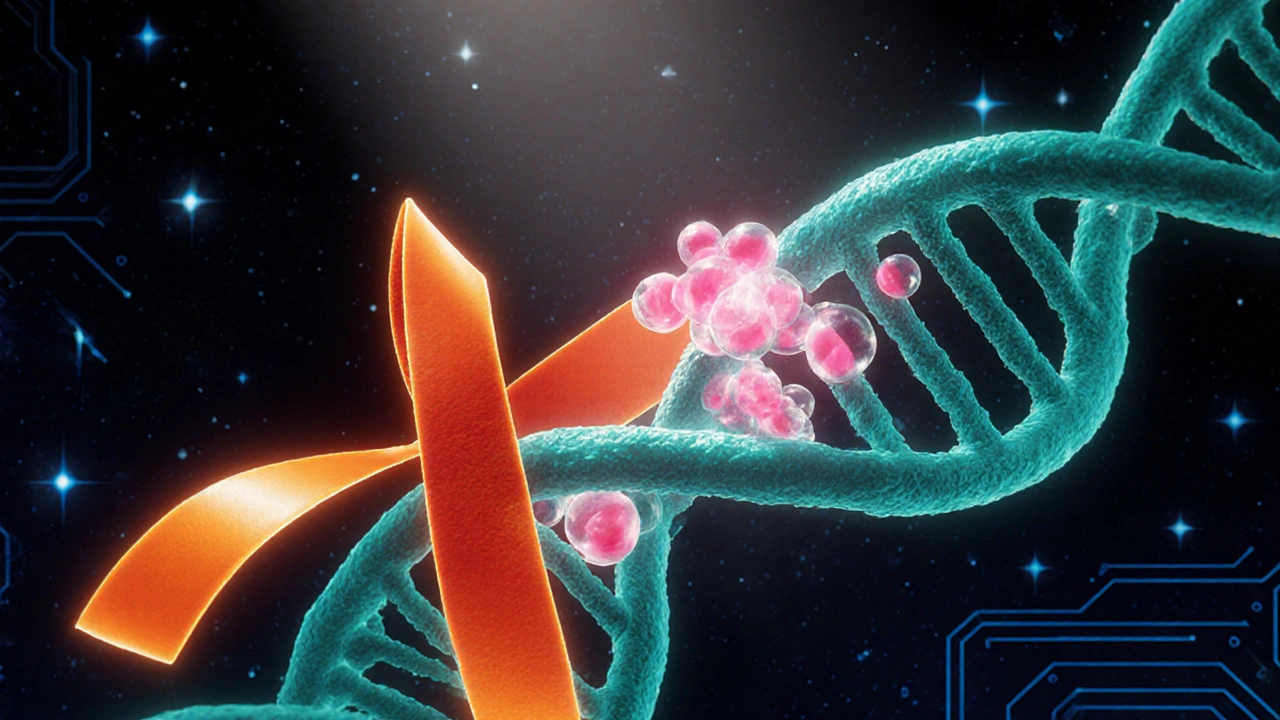HIV Treatment Regimen Calculator
Select Patient Factors
Ever wondered whether the classic HIV drug Retrovir is still worth a look compared to newer options? In 2025 the market is crowded with tenofovir combos, lamivudine pairs, and integrase blockers. This guide breaks down Retrovir’s strengths and weaknesses, lines it up against the most common alternatives, and helps you decide which regimen makes sense for different patients.
Quick Takeaways
- Retrovir (Zidovudine) is an older NRTI with a well‑known safety profile but higher anemia risk.
- Tenofovir‑based regimens (TDF/TAF) dominate first‑line therapy due to potency and once‑daily dosing.
- Lamivudine and Emtricitabine are favored for their low toxicity and synergistic use with other classes.
- Abacavir offers high barrier to resistance but requires HLA‑B*57:01 screening.
- Choosing the right drug depends on kidney function, liver health, pregnancy status, and cost considerations.
What is Retrovir (Zidovudine)?
Retrovir is a nucleoside reverse transcriptase inhibitor (NRTI) that was the first drug approved for treating HIV infection. Marketed as Zidovudine (AZT), it blocks the reverse‑transcriptase enzyme, preventing the virus from copying its RNA into DNA. First approved in 1987, the drug doses at 300mg twice daily for adults and is taken with food to improve absorption.
Retrovir’s long‑standing presence means clinicians have amassed decades of data on efficacy, resistance patterns, and side‑effects. It remains on the WHO’s essential medicines list, primarily for patients who can’t tolerate newer agents or when resistance limits options.
How Retrovir Works - The Mechanism in Plain English
The drug mimics the natural nucleoside thymidine. When HIV’s reverse‑transcriptase tries to insert thymidine during DNA synthesis, Retrovir sits in the slot and stops the chain from extending. The aborted DNA can’t integrate into host cells, halting viral replication.
Because it targets a core step of the virus life cycle, Retrovir is often paired with drugs from other classes-like protease inhibitors or integrase inhibitors-to build a high‑barrier, multi‑drug regimen.

Pros and Cons of Retrovir
- Pros:
- Extensive safety data spanning over three decades.
- Low cost in generic form, especially in low‑income settings.
- Effective against many HIV‑1 subtypes when used early.
- Cons:
- Bone marrow suppression leading to anemia and neutropenia in up to 10% of patients.
- Requires twice‑daily dosing, impacting adherence.
- Potential for mitochondrial toxicity, causing myopathy in rare cases.
Key Alternatives on the Market Today
Below are the most frequently prescribed NRTIs and related agents that compete with Retrovir in 2025.
Stavudine (d4T) - another early‑generation NRTI, less potent than Zidovudine, with notable lipodystrophy risk.
Lamivudine (3TC) - low‑toxicity NRTI, commonly paired with Tenofovir or Abacavir.
Abacavir (ABC) - high‑potency NRTI, contraindicated without HLA‑B*57:01 screening because of hypersensitivity risk.
Tenofovir disoproxil fumarate (TDF) - backbone of many first‑line combos, but can affect kidney function.
Tenofovir alafenamide (TAF) - newer formulation of Tenofovir with reduced renal and bone toxicity.
Emtricitabine (FTC) - almost identical to Lamivudine in efficacy, often used in fixed‑dose single‑tablet regimens.
Side‑Effect Profiles at a Glance
| Drug | Class | Key Advantages | Typical Side Effects | Year Approved |
|---|---|---|---|---|
| Retrovir (Zidovudine) | NRTI | Extensive data, cheap | Anemia, neutropenia, nausea | 1987 |
| Stavudine | NRTI | Low cost | Lipodystrophy, peripheral neuropathy | 1994 |
| Lamivudine | NRTI | Excellent tolerability | Rare headache, mild nausea | 1995 |
| Abacavir | NRTI | High potency, good barrier to resistance | Hypersensitivity (requires HLA‑B*57:01 test) | 1998 |
| Tenofovir (TDF) | NRTI | Strong antiviral activity, once‑daily | Kidney toxicity, decreased bone mineral density | 2001 |
| Tenofovir (TAF) | NRTI | Same potency as TDF with less kidney/bone impact | Elevated lipids, mild weight gain | 2015 |
| Emtricitabine | NRTI | Fits in single‑tablet regimens, good safety | Headache, mild GI upset | 2003 |
When Retrovir Still Makes Sense
Despite newer agents, there are scenarios where Retrovir shines:
- Pregnancy: Zidovudine remains the preferred NRTI for preventing mother‑to‑child transmission in the third trimester, especially when other drugs are contraindicated.
- Resource‑limited settings: Its low price (often under £5 per month in generic form) makes it accessible where tenofovir‑based combos are unavailable.
- Specific resistance patterns: If a patient harbors K65R mutations (reducing tenofovir efficacy) but retains susceptibility to Zidovudine, a Retrovir‑containing backbone can rescue viral control.
How to Choose Between Retrovir and Its Alternatives
The decision hinges on four practical factors:
- Renal function: For eGFR<60mL/min, avoid TDF or TAF; Retrovir and Lamivudine are safer.
- Hematologic health: Patients with baseline anemia should skip Zidovudine; opt for Lamivudine, Emtricitabine, or Tenofovir.
- Coinfections: Hepatitis B carriers benefit from Tenofovir or TAF because those drugs also suppress HBV; Zidovudine offers no HBV activity.
- Cost and insurance coverage: In the UK NHS formulary, Tenofovir‑based single‑tablet regimens are standard, yet some clinics still dispense Zidovudine where budgets are pressed.
Practical Tips for Clinicians and Patients
- Always check complete blood count before starting Retrovir and repeat after 2-4 weeks.
- For patients on Zidovudine, counsel about taking it with food to reduce nausea.
- If switching from Retrovir to Tenofovir, monitor kidney function and adjust dose if eGFR drops below 30mL/min.
- Educate patients on signs of hypersensitivity (fever, rash, SOB) if they’re on Abacavir; immediate discontinuation is mandatory.
- Consider fixed‑dose single‑tablet regimens (e.g., TDF/FTC/DTG) for adherence‑prone individuals; they simplify dosing to one pill daily.
Bottom Line: Tailor the Regimen, Not the Drug
There’s no one‑size‑fits‑all answer. Retrovir remains a valuable tool when cost, pregnancy, or resistance dictate its use. For most treatment‑naïve adults in 2025, tenofovir‑based combos (especially TAF) paired with Emtricitabine or Lamivudine deliver the strongest efficacy with the fewest side effects. Always match the drug’s pharmacology to the patient’s clinical picture, and keep an eye on labs to catch toxicity early.
Frequently Asked Questions
How does Retrovir actually stop HIV?
Retrovir (Zidovudine) mimics the natural nucleoside thymidine. When HIV’s reverse‑transcriptase tries to add thymidine during DNA synthesis, the drug gets incorporated and blocks further chain extension, halting viral replication.
What are the most common side effects of Zidovudine?
The biggest concerns are anemia and neutropenia, which show up as fatigue, shortness of breath, or increased infection risk. Nausea, headache, and mild liver enzyme elevation are also reported.
When would a doctor choose Tenofovir over Retrovir?
Tenofovir (TDF or TAF) is chosen when strong viral suppression is needed, the patient has normal kidney function, and a once‑daily pill is preferred. It also treats hepatitisB, making it a dual‑action choice for co‑infected patients.
Is Retrovir still cost‑effective in 2025?
Yes, generic Zidovudine can be purchased for under £5 per month in the UK, which is cheaper than many branded tenofovir combos. It remains a staple in low‑resource clinics and for patients with specific contraindications to newer drugs.
Can Retrovir be used during pregnancy?
Zidovudine is the recommended NRTI for preventing mother‑to‑child transmission when given in the third trimester, especially if other agents pose a higher fetal risk.









Comments (20)
Jen Basay
October 12, 2025 AT 06:23 AMWow, the breakdown of Zidovudine’s anemia risk is super helpful 😊. I appreciate how the guide lists the pros like cheap generic pricing and decades of safety data, then flips to the cons like bone‑marrow suppression. It really makes the decision process clearer for clinicians dealing with limited resources. The side‑effect table is a goldmine, especially when you need to compare bone health across tenofovir and AZT. Thanks for putting it all together in one place!
Hannah M
October 15, 2025 AT 17:43 PMGreat summary! 🙌 Very easy to skim and get the key points.
Poorni Joth
October 19, 2025 AT 05:03 AMHonestly this article is just regurgitating old textbook stuff. Anyone still pushing zidovudine as a first‑line option is living in the past. The world moved on years ago, and you can’t pretend otherwise.
Yareli Gonzalez
October 22, 2025 AT 16:23 PMI think it’s valuable to keep retrovir in the conversation for specific scenarios, like pregnancy or when resistance limits other choices. Not every regimen fits every patient.
Melissa Gerard
October 26, 2025 AT 02:43 AMSure, cheap is nice, but who wants anemia? 😒
Bansari Patel
October 29, 2025 AT 14:03 PMFrom a broader perspective, the choice between AZT and newer NRTIs reflects a tension between cost‑effectiveness and quality of life. While the newer agents reduce toxicity, they also raise barriers for low‑income health systems. It’s a classic trade‑off that policymakers must grapple with.
Rebecca Fuentes
November 2, 2025 AT 01:23 AMThe inclusion of HLA‑B*57:01 screening for abacavir is a critical safety measure that should be highlighted alongside the anemia risk of zidovudine. Additionally, tenofovir alafenamide’s reduced renal toxicity makes it preferable in patients with compromised kidney function.
Alyssa Matarum
November 5, 2025 AT 12:43 PMTwice‑daily dosing for AZT can hurt adherence compared to once‑daily TDF/TAF.
Lydia Conier
November 9, 2025 AT 00:03 AMI love how the table lines up side effects side‑by‑side – it’s super handy when you’re juggling patient charts. That said, the anemia thing with zidovudine can really knock a patient’s energy, so you gotta watch CBCs carefully. Also, keep an eye on the lipodystrophy risk with stavudine; it’s not as common now but still out there. For pregnant patients, AZT is still the go‑to for preventing transmission, which is a big plus. Just remember to pair it with something that’s safe for the baby too.
ruth purizaca
November 12, 2025 AT 11:23 AMThe article provides a balanced overview without pushing any single regimen.
Shelley Beneteau
November 15, 2025 AT 22:43 PMIt’s interesting to note the evolving resistance patterns, especially the K65R mutation that reduces tenofovir efficacy but still leaves zidovudine active.
Sonya Postnikova
November 19, 2025 AT 10:03 AMNice work compiling all this info! 😊 It really helps clinicians make patient‑centered choices.
Anna Zawierucha
November 22, 2025 AT 21:23 PMOh great, another table. Because we all love spreadsheets more than actual patient stories.
Lolita Rosa
November 26, 2025 AT 08:43 AMBut seriously, the drama of choosing a drug like AZT is real – the stakes are high, the side‑effects are dramatic, and the world just won’t stop judging our choices.
Matthew Platts
November 29, 2025 AT 20:03 PMTrue, anemia isn’t fun, but for some patients the low cost outweighs that risk, especially where alternatives are pricey.
Matthew Bates
December 3, 2025 AT 07:23 AMFrom a pharmacokinetic standpoint, zidovudine has a relatively short half‑life, necessitating BID administration to maintain plasma concentrations above the inhibitory quotient. In contrast, tenofovir alafenamide achieves comparable intracellular diphosphate levels with once‑daily dosing due to its prodrug design, which enhances lymphoid cell uptake while minimizing systemic exposure.
Kasey Mynatt
December 6, 2025 AT 18:43 PMI get why some clinicians cling to AZT – it’s a tried‑and‑true backbone. Yet we can’t ignore the emotional toll of anemia on patients; supporting them means monitoring labs and maybe switching when feasible.
Shriniwas Kumar
December 10, 2025 AT 06:03 AMIn the context of antiretroviral therapy optimization, the genotype‑guided algorithm leverages resistance-associated mutation profiles (e.g., M184V, K65R) to stratify NRTI backbone selection, thereby enhancing virologic suppression rates while mitigating toxicity.
Jennifer Haupt
December 13, 2025 AT 17:23 PMWhen we evaluate the merits of retrovir versus contemporary NRTIs, we must adopt a multidimensional framework that incorporates pharmacodynamics, patient-centered outcomes, and health‑system constraints. First, zidovudine’s mechanism of chain termination is well‑characterized, and its long‑term safety data provide a degree of certainty that newer agents have yet to accrue. Second, the anemia and neutropenia risk, while manageable, can precipitate quality‑of‑life decrements that are especially salient in vulnerable populations such as pregnant women and children. Third, the cost differential remains stark; in low‑resource settings a regimen anchored by generic AZT can be procured for a fraction of the price of a tenofovir‑based single‑tablet regimen. Fourth, resistance pathways differ: zidovudine retains activity in the presence of the K65R mutation that compromises tenofovir, offering a valuable salvage option. Fifth, adherence considerations cannot be ignored; the twice‑daily dosing schedule may hinder consistency compared with once‑daily alternatives, yet some patients prefer the flexibility of split dosing to manage gastrointestinal side effects. Sixth, the evolving landscape of integrase inhibitors and long‑acting formulations may eventually relegate NRTI backbones to a supportive role, but until such therapies are globally accessible, the choice of NRTI remains pivotal. Seventh, clinicians must weigh the ethical imperative to provide the most effective therapy against the pragmatic need to align with the patient’s socioeconomic reality. Eighth, the WHO’s continued endorsement of zidovudine for specific contexts underscores its enduring relevance. Ninth, ongoing clinical trials investigating novel AZT‑based combinations suggest that the drug may yet find renewed purpose. Tenth, it is essential to engage patients in shared decision‑making, transparently discussing the trade‑offs of anemia risk versus affordability. Eleventh, monitoring protocols, such as baseline hemoglobin assessment and periodic CBCs, mitigate the hematologic hazards. Twelfth, integrating multidisciplinary care, including nutrition and counseling, can ameliorate side‑effects. Thirteenth, health‑policy makers should consider tiered pricing models that make newer agents more accessible, reducing reliance on older drugs. Fourteenth, education of primary care providers on resistance interpretation enhances appropriate AZT use. Finally, a balanced therapeutic algorithm that situates retrovir alongside tenofovir, abacavir, and lamivudine, calibrated to individual patient parameters, will optimize both virologic control and overall wellbeing.
Alan Clark
December 17, 2025 AT 04:43 AMCool stuff, love the clear tables – super helpful for quick ref.